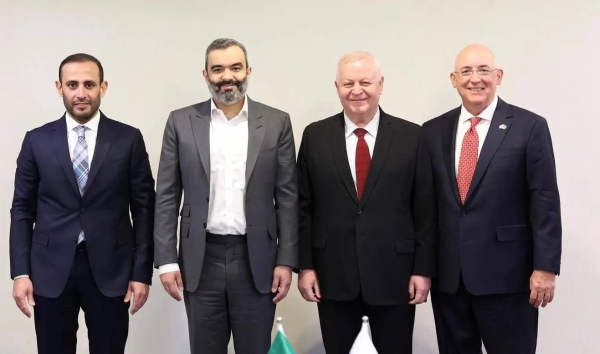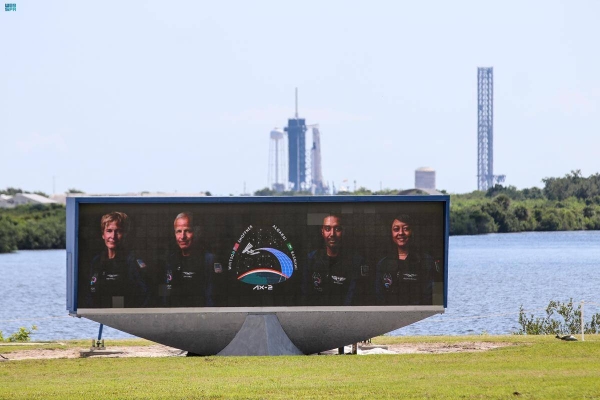
Saudi Arabia’s recent announcement that it was sending two Saudi astronauts to the International Space Station (ISS) has kicked off talks about the Kingdom’s serious endeavor to benefit from the space economy as a giant sector, where global visions of sustainability and technology intersect.
The astronauts will make their trip during the second quarter of 2023, in a first-of-its-kind move for the Kingdom.
Last year, the Saudi government decided to establish the Supreme Space Council in view of the strategic importance of the space sector, which represents the main engine to stimulate innovation and inspire future generations, according to a statement of the Communications, Space and Technology Commission (CSTC).
Saudi Minister of Communications and Information Technology Abdullah Alswaha said the efforts would focus on creating the space market and stimulating research and innovation, and then moving towards the stage of regulation and governance.
The authority will play a pivotal role in setting the adequate regulations, as well as coordinating and cooperating with space regulators at the global level and building relationships with industry stakeholders.
Capacity building
In September 2022, the Saudi Space Authority launched the Kingdom’s Astronaut Program, which aims to qualify experienced national cadres for long- and short-term space flights. The program also seeks to train Saudi astronauts to participate in scientific experiments, international research, and future space-related missions.
The program aims to take advantage of the promising opportunities offered by the space sector and its industries globally and to contribute to research to serve humanity in a number of priority areas, such as health, sustainability and space technology.
Last week, the Saudi Press Agency (SPA) reported that Saudi female and male astronauts Rayana Bernawi and Ali Al-Qarni will join the crew of the Axiom Mission 2 (or Ax-2), with the aim of building national capacities.
The space mission aims to empower capabilities of Saudi scientists in human spaceflight geared towards serving humanity and benefiting from the promising opportunities offered by the space industry.
SPA added that the journey would start from the United States to the ISS. The program includes two other astronauts Maryam Firdous and Ali Al-Ghamdi, who will be trained on all mission requirements, but not take part in the journey.
In 1985, Prince Sultan bin Salman bin Abdulaziz was the first Arab astronaut to participate in a space flight, which also launched from the United States.
NASA announcement
NASA announced that Bernawi and Al-Qarni will take off “in the spring of 2023” from the Kennedy Space Center in Florida, in the United States, on a private mission operated by Axiom Space.
The two Saudi astronauts will accompany Peggy Whitson and John Shoffner on the Ax-2 mission, a Crew Dragon flight set to launch no earlier than May 1, 2023, to the ISS.
Economic dimension
In previous remarks, Minister Alswaha emphasized the importance of the space sector as “the next trillion global economy”, saying that the establishment of Supreme Space Council was “an important step to stimulate innovation and inspire future generations for our beloved country.”
Observers have underscored the importance of the decision, which corresponds with the vision followed by Saudi Arabia in launching programs and projects that are compatible with its financial and human capabilities, to create complementary industries for this sector, and a specialized market in the world of space.
Space agreements
Saudi Arabia had earlier concluded many agreements and contracts, including the Artemis Accords with the NASA, to join the international coalition in the field of civil exploration and the use of the moon, Mars, comets and asteroids for peaceful purposes.
Government attention
Alswaha said the fact that Prince Mohammed bin Salman, Crown Prince and Prime Minister, was president of the Supreme Space Council was a clear message of the importance that the Kingdom places on the space sector.
The council will focus on three main axes: adopting policies and strategies for the sector’s programs, approving its annual plans and monitoring the implementation of its national strategy, and achieving compatibility with various sectors and national needs.
Saudi transformation
The decision to establish the Supreme Space Council came in line with the industrial and economic transformation in Saudi Arabia, based on the initial steps taken by the Saudi Space Authority since its establishment in 2018.
These moves have resulted in the conclusion of an agreement in mid-March with the British Space Agency for cooperation in the field of peaceful use of outer space, aimed at providing a framework for cooperation in space activities.
Saudi satellites
Between 2000 and 2019, the Kingdom launched 16 Saudi satellites into space under the supervision of the King Abdulaziz City for Science and Technology (KACST). The latest was the Saudi Communications Satellite (SGS1), which was launched on February 6, 2019, bearing the signature of Crown Prince Mohammed with the words, “Above the clouds.”
SGS1 works to serve the modern satellite communications sector, which includes broadband and secure military communications, as well as the provision of communications to semi-remote and stricken areas for use in various fields of sustainable development such as: applications (high-speed broadband communications, and secure communications for government agencies).
The satellite is operated and managed through advanced ground control stations in the Kingdom.
An international map
Dr. Faisal Al-Fadil, member of the Saudi Shura Council, said the decision to establish the Supreme Space Council is part of the moves taken by Saudi Arabia in all economic and social fields, which aim to place the Kingdom on the international map in science, economy and politics.
According to Al-Fadil, these three branches depend on two pillars: cadres and a clear strategy.
Twenty companies
The Saudi Space Authority is currently seeking to attract 20 emerging companies in the fields of space tourism, exploration, satellite communications and space photography.
The program will enable these companies to work and connect with world-class resources to enhance their chances of success, in partnership with Techstars, a global investment firm that provides access to capital, individual mentorship, a global network, and customized programming for early-stage entrepreneurs.
Space economy
According to Morgan Stanley’s 2018 report, the size of the space economy in the world is $360 billion. It is expected to reach $1.1 trillion in 2040 and $2.7 trillion by 2050.
The G20 countries account for the largest share, at about 92 percent.
The private sector
The private sector plays a pivotal role in the space industry. According to the latest statistics, the sector achieved huge revenues of $254 billion, through six main activities that included satellite communication services and applications by around 36 percent, chips and receivers for satellite navigation by 23 percent, as well as ground equipment and devices by 23 percent, and satellite manufacturing by 9 percent.
This is in addition to space applications and remote sensing, and services for launching vehicles and human space flights by about 5 percent for each activity.










